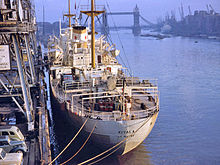Pool of London
The Pool of London is a section of the River Thames in London. It starts at London Bridge and goes downriver to Rotherhithe . This is where the original port of London was, until the 20th century it was commercially vital for the city. The Upper Pool extends from London Bridge to Tower Bridge , the Lower Pool from Tower Bridge to Rotherthide.
For centuries, shipping to London has ended at London Bridge, which does not allow large ships to pass through. In the 16th century, due to the increasing traffic, ships began to anchor in the middle of the river and unload there onto smaller boats. By the 18th century, the pool had become the busiest stretch of river in the world. At the end of the 18th century, the pool was so narrow that ships anchored where they could find space - and thus almost always blocked the way for other ships. Calculations from 1798 assumed that at any given point in time there were an average of 689 ships with a displacement of 141 tons each. A third of these were ships from the West Indies , which, due to their greater displacement, made up two thirds of the mass. The increasingly larger ships also had problems to bypass the treacherous river points around the Isle of Dogs to get to the pool.
The construction of new docks further east relieved the pool in the 19th century. The port shifted to the east. On the Isle of Dogs originated West India Docks . Still, the pool was a hub of activity. The importance of its shipping prevented the construction of the Themsequerungen east of London Bridge. First tunnels were built, followed by Tower Bridge as a bascule bridge at the end of the 19th century.
With the advent of the container and the changes in shipping, the pool and the docks there became less important. The new big ships couldn't get up the Thames far enough. Since the 1990s, London has been trying to rededicate the area with the Pool of London Partnership. The attempt to re-establish the term Pool of London in colloquial language and among tourists, however, was unsuccessful.
Today there are several docks for the London River Service by the pool, as is the HMS Belfast permanently attached to the pool.
literature
- Charles Craig, Graham Diprose, Mike Seaborne: London's Changing Riverscape frances lincoln ltd, 2009 ISBN 0711229414
Remarks
- ^ Walter M. Stern: The First London Dock Boom and the Growth of the West India Docks , Economica, New Series, Vol. 19, No. 73 (Feb. 1952), p. 59
- ^ Walter M. Stern: The First London Dock Boom and the Growth of the West India Docks , Economica, New Series, Vol. 19, No. 73 (Feb. 1952), p. 66
- ^ Hidden London: Pool of London

